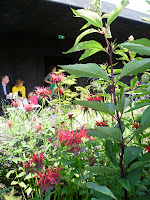The Shape of Things to Come: New Sculpture
at the Saatchi Gallery until October 16
open every day 10am-6pm
This jolly mannequin is an arresting figure. He’s part of a merry throng of dancers, but almost at once we suspect that all is not well. So we walk into and around the group, stop and browse. We confront their antics. They smile back, but there’s an oddly hypnotic quality in their eyes. Those grins are sinister, half street hustler, half clown. The queasy black coating is dripping like tar. You notice that the single figure shown here is the only one with hands and fingers – the arms of the rest metamorphose into rigid polystyrene planks in a fetching baby pink.The dancers in the artwork (made of polyurethane foam) are all copies of one composite character: a 16th/17th century trader created out of many figures, some historical. There's also a reference to Rembrandt’s painting The Nightwatch. De Jong explains that in this nightmarish song and dance ‘the clones are ripping each other off... and dancing towards their destiny: self destruction’.
 De Jong is Dutch. This installation recalls the monument in New York’s Battery Park celebrating the Dutch purchase of Manhattan allegedly for beads and mirrors. His constructions often deal with unfair deals, with profiteering and colonialism.
De Jong is Dutch. This installation recalls the monument in New York’s Battery Park celebrating the Dutch purchase of Manhattan allegedly for beads and mirrors. His constructions often deal with unfair deals, with profiteering and colonialism. The artist comments: ‘The Dutch seem to be very proud of their historical conquests. For me as a kid growing up there, they are like adventure stories, with costumed characters as in Hook and Peter Pan’. When he was asked ‘Do you see your sculptures as monuments of sorts?’ he replied ‘Not deliberately, but there is a strong reference to the powerful meaning and function of monuments in my work...Maybe they’re monuments for the moral subjects that are unspoken ...We humans have to face the fact that we are part of a natural process...it is embedded in our system, but there is hope!
Morality, compassion and intelligence can save us.’
www.folkertdejong.com
www.saatchi-gallery.co.uk/artists/sculpture/













